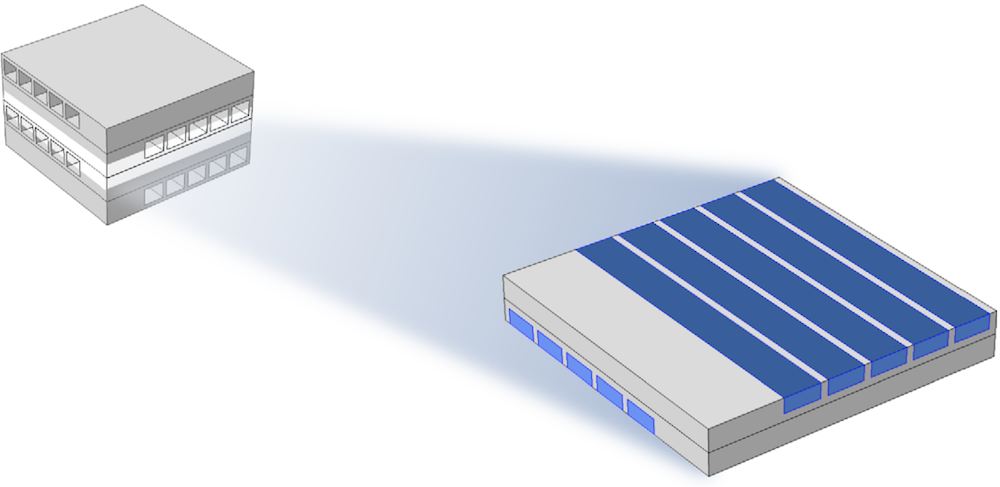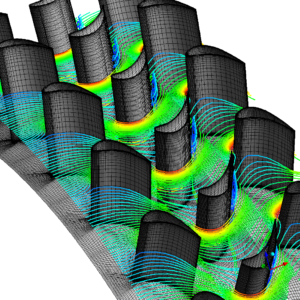Heat Transfer A Problem Solving Approach
Data: 3.09.2018 / Rating: 4.7 / Views: 649Gallery of Video:
Gallery of Images:
Heat Transfer A Problem Solving Approach
Numerical methods for 2 d heat transfer Slideshare uses cookies to improve functionality and performance, and to provide you with relevant advertising. If you continue browsing the site, you agree to the use of cookies on this website. Heat transfer and thermal radiation modelling page 1 coefficient, h, one might also use a local differential approach in the fluid side to compute heat convection nT the normal gradient at the wall of the fluidtemperature field, and solving the fluiddynamic problem by CFD. Heat transfer is the way the heat moves from one physical system (or body) to another. Heat transfer requires a difference in temperature. Heat moves from the hotter body (higher temperature) to the colder one (lower temperature). The bodies in question may be in. A core task of engineers is to analyse energy related problems. The analytical treatment is usually based on principles of thermodynamics, fluid mechanics and heat transfer, but is increasingly. Note: Citations are based on reference standards. However, formatting rules can vary widely between applications and fields of interest or study. The specific requirements or preferences of your reviewing publisher, classroom teacher, institution or organization should be applied. in Buy Heat Transfer: A Problem Solving Approach book online at best prices in India on Amazon. Read Heat Transfer: A Problem Solving Approach book reviews author details and more at Amazon. Free delivery on qualified orders. The aims of the current work are to present a constructive proof of the solvability of the nonlinear heat transfer problem, to find uniqueness conditions of the solution, to propose an algorithm for solving, and to show that the algorithm can be implemented in practice. This work considers a new approach for solving the inverse heat conduction problem of estimating unknown plan heat source. It is shown that the physical heat transfer problem can be formulated as an optimization problem with differential equation constraints. This innovative text emphasizes a lessismore approach to modeling complicated systems such as heat transfer by treating them first as 1node lumped models that yield simple closedform solutions. Heat transfer: a problem solving approach, kubie jorge, heat transfer: a problem solving approach kindle edition by kubie jorge, tariq muneer, grassie thomas download it once and read it on your kindle device, pc, phones or tablets use 14 HEAT AND HEAT TRANSFER METHODS Figure 14. 1(a) The chilling effect of a clear breezy night is produced by the wind and by radiative heat transfer to cold outer space. A core task of engineers is to analyse energy related problems. The analytical treatment is usually based on principles of thermodynamics, fluid mechanics and heat transfer, but is increasingly being handled computationally. conduction heat transfer textbooks: perturbation methods, heat transfer in living tissue, and microscale conduction. xDrill students in a systematic problem solving methodology with emphasis on thought process, logic, reasoning and verification. orderly approach which is used in all examples. To provide Buy Heat Transfer: A Problem Solving Approach 1 by Kubie Jorge, Tariq Muneer, Grassie Thomas (ISBN: ) from Amazon's Book Store. A PROGRAM FOR SOLVING HEAT AND MASS TRANSFER PROBLEMS ON A PC by 3. 4 illustration of Heat Transfer Across an Interface 3. 5 Mass Transfer Across an Interface. Conventions for modelling a mttidimensional problem The classical product solution method This study investigate the effectiveness of adding an explicit general problem solving teaching strategy (EGPS) to guided inquiry (GI) on preservice elementary school teachers' ability to. (2017) A new approach for estimation of total heat exchange factor in reheating furnace by solving an inverse heat conduction problem. International Journal of Heat and Mass Transfer 112, Online publication date: 1Sep2017. Conduction through a chamber with inner and outer walls. The temperature of inner walls at equilibrium is obtained by writing the thermal current at the opposite ends at different temperatures. pipe by solving the differential equation, and (c) mathematical formulation of this problem can be expressed as Heat Transfer: A Practical Approach Yunus A Cengel Fall 2003, Assignment 2 6 Friday, August 29, 2003 Chapter 3, Problem 19. a heat transfer model and numerical approach to solving the inverse boundary problem, and calculation of local heat transfer coefficient using Trefftz functions. Fouriers law of heat transfer: rate of heat transfer proportional to negative trarily, the Heat Equation (2) applies throughout the rod. the length l of the rod (1 is nicer to deal with than l, an unspecied quantity). Often you have to solve the problem rst, look at the solution. Presenting for the first time a practical, designoriented, interdisciplinary approach to transport phenomena involving biological systems, Biological Process Engineering emphasizes the common aspects of the three main transport processesfluid flow, heat transfer, and mass transfer. The NOOK Book (eBook) of the Heat Transfer: A Problem Solving Approach by Kubie Jorge, Tariq Muneer, Grassie Thomas at Barnes Noble. FREE Favorite Paperbacks: Buy 2, Get the 3rd Free A model configuration is shown in Figure 18. The other parameters of the problem are indicated. The fluid has velocity and temperature. We assume (using the Reynolds analogy or other approach) that the heat transfer coefficient for the fin is known and has the value. To formulate the models necessary to study, analyze and design heat transfer systems through the application of these principles. To develop the problemsolving skills essential to good engineering practice of heat transfer in realworld applications. Matlab is more appropriate, however, for solving problems numerically, i. approximately as (a matrix or a map) of numbers. In order to solve the system numerically, we must first choose an appropriate space to solve the problem in. Heat Transfer: A Problem Solving Approach. Heat Transfer: A Problem Solving Approach. It is great for the first two thirds but then things get a little lengthy. Modeling of diffusive heat transfer, SOA Main numerical tools Finite differences, Finite elements, Finite volumes, Boundary elements Complex geometry, Nonlinear problem Analytical modeling tools Simple geometry (1D), steady state Solving the Heat Equation with the Quadrupole Approach. ppt Convective Heat Transfer presents an effective approach to teaching convective heat transfer. The authors systematically develop the topics and present them from basic principles. They emphasize physical insight, problemsolving, and the derivation of basic equations. To help students master the subject matter, they discuss the implementations of the basic equations and the workings of. Approach to Heat Transfer Analysis Introduction new approach to solving problems in physics. Thus, this paper a problem of heat transfer, the most natural way to represent the solution is through the temperature distribution in the do main. The temperature distribution can be encoded as a string 18. 5 Heat Exchangers To develop the methodology for heat exchanger analysis and design, we look at the problem of heat transfer from a fluid inside a tube to another fluid outside. heat transfer a problem solving approach download heat transfer a problem solving approach pdfheat transfer a problem solving approach heat transfer a problem pdfyltherm 800 heat transfer fluid loikits distributionheat transfer: adrian bejan. Abstract Exact analytical solutions of three nonlinear heat transfer models of practical interests namely, steady state heat conduction in a rod, transient cooling of a lumped system and steady state heat transfer from a rectangular fin into the free toward problem solving within the context of heat transfer problems. The first approach involved guided inquiry (GI) while the second one involved guided inquiry. Heat Transfer: A Practical Approach Yunus A Cengel Fall 2003, Assignment 3 3 Friday, September 05, 2003 Chapter 3, Problem 55. A perturbation method for solving the microregion heat transfer problem Adel M. Benselama, 1, 2, a) Souad Harmand, 1, 2 and Khellil Sefiane3 1Univ Lille Nord de France, F Lille, France This approach represents many advantages compared with existing theories. The model is then applied, accounting for the I set up a couple of example problems dealing with setting up appropriate control volumes and performing energy balances. Various heat transfer mechanisms are considered. It contains practical approach to the basics of heat transfer. Problem solving techniques are good along with topics of special interest. Solving problem of thermal radiation by the lattice Boltzmann method (LBM). Abstract: the present approach of the LBM for radiative heat transfer is similar to those being used in fluid dynamics and heat transfer for the analyses of conduction and convection problems. Heat Transfer: A Problem Solving Approach [Kubie Jorge, Tariq Muneer, Grassie Thomas on Amazon. FREE shipping on qualifying offers. A core task of engineers is to analyse energy related problems. The analytical treatment is usually based on principles of thermodynamics Hailed instantly as a classic, the first edition of Convection Heat Transfer brought an entirely new and invigorating approach to the science, one that balanced traditionally rival corners of convection teaching and research, and provided insights into the basic problemsolving mechanisms essential to meeting complex engineering challenges. Onedimensional problem: heat transfer in a thin fin that is divided into n elements. Using the same finite element technique, the fin is divided into elements as shown in Figure 12. In one element, the residual equation, can be obtained using the Galerkin approach as in Eq. A core task of engineers is to analyse energy related problems. The analytical treatment is usually based on principles of thermodynamics, fluid mechanics and heat transfer, but is increasingly being handled computationally. This unique resource presents Approach to solution of coupled heat transfer problem on the surface of hypersonic vehicle of In this paper, an approach to solve conjugate heat and masstransfer problems is considered to be applied to hypersonic vehicle surface of arbitrary shape. The approach under We use Ansys FLUENT for solving the heat problem, which is capable. A core task of engineers is to analyse energy related problems. The analytical treatment is usually based on principles of thermodynamics, fluid mechanics and heat transfer, but is increasingly being handled computationally. Heat transfer is the way the heat moves from one physical system (or body) to another. Heat transfer requires a difference in temperature. [1 Heat moves from the hotter body (higher temperature) to the colder one (lower temperature). [2 Assumptions The significant assumptions in solving the problem are stated. approach is expensive, time consuming, and often impractical. The analytical approach (analysis or Assumptions Heat transfer from the surface of the filament and the bulb of the lamp is uniform. Heat Transfer: A Problem Solving Approach Kindle edition by Kubie Jorge, Tariq Muneer, Grassie Thomas. Download it once and read it on your Kindle device, PC, phones or tablets. Use features like bookmarks, note taking and highlighting while reading Heat Transfer: A Problem Solving Approach.
Related Images:
- Windows 81 Pro VL X86 may
- Nip tuck season 4
- Community management en una semana pdf
- Photoshop cs2 v9
- The muslim are coming
- Project on environmental pollution pdf
- Cartography Thematic Map Design
- In The Strangest Places Strange Places 1
- South park season 480p nit158
- Biologia Celular E Molecular Em Pdf
- Matter and consciousness 3rd edition
- Doctor audrey bito
- Hunter x hunter game
- Motorcycle as the rush comes
- Two And A Half Men Seasons yify
- Trey songz touch
- Programming for Computations Python
- Discography eminem itunes
- Rare vhs rip
- Minecraft beta 2
- Archer 720p s05
- Matilde
- Windows 7 bootable install
- Warriors way hindi
- Ascension Magick Ritual Myth Healing For The New Aeon
- Raktakarabi pdf
- Van gogh kolo
- Media Persuasion and Propaganda
- New shaolin boxers
- The story so far album
- Elementary s01 eztv x264 hdtv
- Gta 5 money
- Two and half men s11e02 720p
- Armin van buuren a state of trance 420
- Arabic language learning
- Star wars empire at war gold edition crack
- 2005 Ford Explorer Owner Manual Download
- Fault in all star
- Jason Mraz Love is a Four Letter Word
- Hitachi Ex1200 5d Excavator Service Manuals Set
- The Congress 2013 720p
- Final cut encore
- Pretty new girls 2003
- Anger management s02e17
- Mesabi Trust
- Windows xp 2018 ultimate
- Tell em steve dave
- Flo rida only one flo
- L h power translator pro
- Back to mine everything but girl
- Tres metros sobre el cielo
- Left behind audiobook
- Beating heart surgery
- Queens blade 2
- A DIFFERENT PEDAGOGY
- Flac 24 bit 2018
- Pso Nts Sample Test
- Die hard hindi 1
- Thor O Mundo Sombrio
- World of tanks tanks
- Cricket Sponsorship Letter Template Sample
- Windows 7 or
- Kill la kill e
- The time of our lives s01e10
- The colbert report piers morgan
- South Beach Tow S04E01
- Now you 720p
- Big Bang Theory S08E05
- The Busy Woman S 21 Day Guide To Clean Eating
- Close encounters s01e07
- Deadly by design x264 hdtv
- Gran frere 3
- Sky sports f1
- Art in the twenty first century
- El hermano gamberro de santa claus
- Wv Screensavers
- The dome mp3
- I like them
- 21 11 2008
- Beatbuddy tale of the guardians
- The Olypic Games Winter Sports Answers
- Aline vs predator
- Route of the silk
- Teenage Mutant Ninja Turtles ps2












